#hg analysis
Text
I have been pondering Bad and Cellbit's past for a while and the varied ways in which they both perceive it. Bad's immortality and experience of witnessing traumatic event after traumatic even unfortunately renders him somewhat well-adjusted with these emotions. Not saying he is incapable of experiencing regret. It's just that after everything he has been through, he has had millenniums to sit with not just the consequence but also the effects, the reparations ,the surrounded grief of not just him but also the other mortals that had been affected .
On the other hand, what Cellbit is going through now Bad probably has already been there centuries ago. It's just constant exposure and survival through so many traumatic situations has now made Bad somewhat neutral to them. That's why him losing the eggs is such a big deal because Bad hasn't had familial connections in god knows how long. Maybe apart from Foolish Bad has never had a constant in his life and he had brought himself to be okay with that. But now that he is experiencing such a huge loss he has no clue how to deal with it and that is why he is spiraling.
Cellbit being a mortal provides a lot of reason to the regret regarding his past that he had been feeling. Killing and destruction was the only language he spoke but he learnt to separate that part of himself once Roier and Richarlyson entered his life proving to be his anchor. But now with Richarlyson gone and him being smacked with the revelation of a life he could have had, everything has becoming a confusing mess of what ifs and what could have beens. Hence, it makes sense that Cellbit has regressed to a way of life he holds familiarity with and which provides him the most control he has had in years and its great to know he has a friend a past mentor aiding his steps all along his journey.
116 notes
·
View notes
Text
completely random thought but thinkin about like. how interesting it is that what happened to qcellbit in the war and what he was forced to do to survive traumatized him and still clearly upsets him. like we all know that. but given his interactions with bbh he still feels a sense of nostalgia, referring to them as the "good times" and reminiscing n whatnot. and it could all be a result of the headspace he's in rn, perhaps glorifying his childhood as a means of reinforcing his "i have always been this way" mentality to help justify his violence against the fed workers and/or clinging to the "good" moments he had growing up in an awful environment because that peaceful childhood was stolen from him.
anyway all this is to say. what if even back then, in order to cope, cellbit thought about the wars as a game: hunting alongside bbh, strategizing, taking people out, collecting "loot," upgrading their gear. and when they're the last ones standing, they win! just,, interpreting the "games" part of "hunger games" as a young, scared little cellbit subconsciously putting distance between himself and the horrors he experienced/committed on the daily and trying to motivate himself to keep going by making it a "fun game to play." and how that might affect how he thinks of it now. like on one hand he's probably aware that it was a seriously messed up situation to be dropped into as a kid, on the other hand, he can't deny that he was having fun.
also i do believe that even outside this "it's all just a game" mentality, cellbit and bbh had some pleasant moments that cellbit is still clinging to (and perhaps blowing out of proportion; nostalgia and rose-tinted glasses and all that). cellbit goofing around while setting up camp for the night. bbh looting a cool jacket (or perhaps a sick pair of goggles?) off a body and giving them to a delighted cellbit. cellbit trying to teach bbh some portuguese, bbh teaching cellbit new words in english. cellbit, bored, hanging upside down from a tree by his legs while waiting for bbh to finish looking at the map and call their next move. a flawless double takedown where neither of them broke a sweat and bbh greatly praised cellbit's skills and cellbit smiled for the rest of the day. (are you proud of me? are you proud of me?) a tree branch breaking and falling directly in front of cellbit and cellbit screeching and bbh laughing harder than cellbit has ever heard him laugh before, so much so that he forgets his embarrassment and starts laughing too.
just,,, man. what exactly is cellbit referring to when he brings up "the good times" with bbh. it's so fun to think about.
#wowow this got long fhdskj. i have so many scattered thoughts abt this you have no idea. (or like. i guess you do now lol)#dont mind me im just rambling#character analysis#qsmp cellbit#hgduo#q!cellbit#hg duo#tbh might delete this later we'll see how i feel abt it#ive just been thinkin abt hgduo a lot bc im workin on a fic that i miiiight end up posting? we'll see.
23 notes
·
View notes
Text
They should've let Katniss be unhealthily skinny in the movie.
I understand a little bit how Jennifer Lawrence or whoever didn't want to present yet another very skinny main female character. They didn't want to ~promote~ anything. They wanted their main girl to be a healthy-looking skinny. However, I think they missed an opportunity.
Katniss as a character is starving to death. She is struggling to survive. In the books, her drive to feed herself and her family is an important part of her character, and it's important that she isn't skinny because she wants to be; she's skinny because she literally cannot get herself to a healthy weight. The Capitol designers wanted to give her a boob job after the Games to make her look better. Seeing a healthy-slim Jennifer Lawrence represent this felt dishonest. It does her character a disservice to ignore that reality. And frankly, it felt like it had the opposite effect of its goal, because it sent the message that this is what people who are starving to death look like. That starving to death produces a hot skinny.
What if they'd given us a scary skinny Katniss? What if they'd started the movie with her starving to death, showed her struggling with energy and strength, showed her eating a lot during training to try to bulk up? The movie could have used this opportunity to focus on the detrimental effects of low body condition and malnourishment. We could've had an obviously healthier weight Katniss in Catching Fire and Mockingjay and seen her enjoying no longer starving to death. We could've seen her training for the Quell, putting on muscle like she's never been able to before. They could've left in the Capitol party vomit scene, too, and not shied away from the subject matter.
The movies tried to dodge the problem of ~promoting~ unhealthy thinness and ended up ignoring the way that very issue is tackled in the books. I almost wonder if the problem isn't that Hollywood didn't want a skinny Katniss detrimentally affecting young girls' body image, but that Hollywood couldn't handle an honest representation of what being starving skinny actually means. They didn't want to be the "bad guys" for this one, but they didn't want to be honest about the problem or fix anything either. The decision not to give us starving skinny Katniss was because showing a healthier female body was trendy, not because they cared about any message. Cowards.
#hunger games#katniss#everdeen#jennifer lawrence#gary ross#movie#hg movie#books vs movies#body image#analysis
11 notes
·
View notes
Text
Daenerys Targaryen, Martians, Eatable Ants and the Influence of The War of The Worlds on ASOIAF Part 3
January 18, 2023
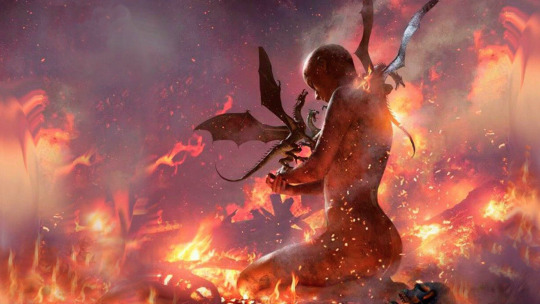
©Michael Komarck for the 2009 A Song of Ice and Fire Calendar
It’s been a long time coming, but here we are. After almost 4 years, I have finally completed my essay series on the influence of H.G Wells, The War of the Worlds (TWOTW) on A Song of Ice and Fire (ASOIAF). Before you begin, I should say that if you have not already done so, go back and first read parts one and two in the order they were written. This way, you get a better feel for the scope of what Martin has done in integrating TWOTW into his magnum opus.
In part one, I proposed that the Targaryens and their dragons represent the Martian invaders from Wells’ classic story and showed the numerous ways Martin compares them to visitors from the red planet. Then in part two, I dived deep into ants…how Wells and Martin used them in the same metaphoric way in their stories and what this might indicate about the future arc of Daenerys Targaryen.
Now in the final chapter, I take a closer look at how the Targaryen words fire and blood reverberate as deeply in TWOTW as it does in ASOIAF…pointing towards the conflagration that both the Martians and dragons will bring to the world. I also provide my theory on the location of Dany’s house with the red door and what it truly means to her and the in-world characters. Finally, I briefly discuss the clues in TWOTW that echo ones about Euron Greyjoy in ASOIAF and what they might potentially suggest about the convergence of his story with Dany’s. And so, let’s jump right in.
Fire and Blood and the Targaryen colors of red and black are not just motifs in ASOIAF. They are also layered throughout TWOTW. There is an overabundance of comparisons of the Targaryens and their dragons to the Martians in the text of ASOIAF. On the dragon side, this is especially true with Balerion and Drogon and their black fire. George plainly shows how it represents his version of Wells’ Martian’s Black Smoke.
As I noted in the post I made after the publication of part one of this essay series, George refers to Mars as the Blood and Fire planet, and wrote a long introduction for an anthology of Mars stories he edited where he discussed his lifelong fascination with the planet and its influence on him and and other writers of the genre.
Interestingly enough, he more recently mentioned in a blog post from March 2022 that he’s thinking of calling part two of F&B, Blood and Fire. This further supports my thesis that he has written the Targs as the Martians invaders of the story. ASOIAF is in a way, the story he says that he’s always wanted to write about Martians and the storied planet of Mars.
THE MARTIAN LANDSCAPE AND ASOIAF
As is the case in ASOIAF, the Targaryen words of Fire & Blood, and the colors of red and black are major motifs in TWOTW. From the beginning of the novel, Wells makes it clear that the Martians like George’s dragons were bringing a firestorm to the earth.
The storm burst upon us six years ago now. As Mars approached opposition, Lavelle of Java4 set the wires of the astronomical exchange palpitating with the amazing intelligence of a huge outbreak of incandescent gas upon the planet. It had occurred towards midnight of the twelfth; and the spectroscope, to which he had at once resorted, indicated a mass of flaming gas, chiefly hydrogen, moving with an enormous velocity towards this earth. This jet of fire had become invisible about a quarter past twelve. He compared it to a colossal puff of flame suddenly and violently squirted out of the planet, “as flaming gases rushed out of a gun.”
A singularly appropriate phrase it proved.
The War of the Worlds: The Eve of the War
I discussed many of the direct comparisons between the Targs and the Martians by George in part one. These include how the Martians’ cylinder like space ships were first thought to be meteors just like the Qarthian myth suggest was the case with the dragons of Planetos; the cylinders symbolically serving as eggs from which Martians are born on earth and how the crusted metal of their ship is described like the metallic scales on a dragon egg; the plethora of comparisons of both the Martians, Targs and their dragons to snakes; how both the dragons and Martians’ heat ray are described as swords above the world; the association of both to pits; and of course, the ants, the ants, the ants.
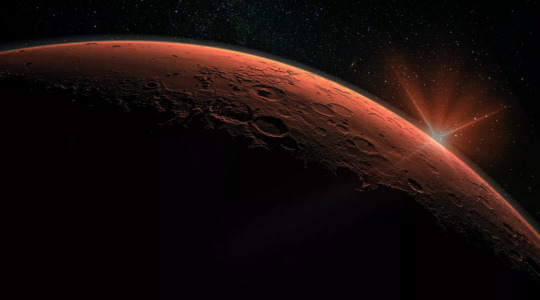
Elen11/Getty Images
Both Wells and George play with the idea blackness of space as a primordial sea. This is an idea that’s at the heart of many of the world’s myths and has been used by other fantasy and science fiction authors on numerous occasions.
Near it in the field, I remember, were three faint points of light, three telescopic stars infinitely remote, and all around it was the unfathomable darkness of empty space. You know how that blackness looks on a frosty starlight night. In a telescope it seems far profounder. And invisible to me because it was so remote and small, flying swiftly and steadily towards me across that incredible distance, drawing nearer every minute by so many thousands of miles, came the Thing they were sending us, the Thing that was to bring so much struggle and calamity and death to the earth.
The War of the Worlds: The Eve of the War
As the unnamed narrator looks through the telescope, it’s as if he is looking at the cosmic ocean, which is a theme that George plays with throughout ASOIAF regarding the weirwoods and being ‘under the sea.’ However, we are not here to discuss the primordial sea, but rather the emphasis put on red and black in both Wells and George’s work.
There is the blackness of space reference in the passage above, which the narrator is viewing at night from a night black observatory. There is the moving black mark on the cylinder that alerts Ogilvy to the fact that it is being opened from the inside.
And then he perceived that, very slowly, the circular top of the cylinder was rotating on its body. It was such a gradual movement that he discovered it only through noticing that a black mark that had been near him five minutes ago was now at the other side of the circumference. Even then he scarcely understood what this indicated, until he heard a muffled grating sound and saw the black mark jerk forward an inch or so. Then the Thing came upon him in a flash. The cylinder was artificial—hollow—with an end that screwed out! Something within the cylinder was unscrewing the top!
The War of the Worlds: The Falling Star
There is how Wells describes the crowd standing around the pit where the Martians were about to be born.
WHEN I RETURNED to the common the sun was setting. Scattered groups were hurrying from the direction of Woking, and one or two persons were returning. The crowd about the pit had increased, and stood out black against the lemon yellow of the sky—a couple of hundred people, perhaps.
The War of the Worlds: The Cylinder Opens
The sky turning yellow is a harbinger. A yellow sky means that a storm is brewing. This seems an apt metaphor considering what occurred on the sand dunes of Horsell Common.
Another way black is used as an important symbol is how Wells compares people to black ants as they flee from the Martians. I described the symbolic importance this in detail and how Martin uses them in the same metaphoric manner in his story, as well as what it implies about Dany’s future arc in the last chapter and so I will not do so again here.
There is also the black machine the Martians’ travel in from which they dispense their heat ray. Not surprisingly, the narrator describes it as a sword from above just as Xaro Xhoan Daxos describes Dany’s dragons.
It was sweeping round swiftly and steadily, this flaming death, this invisible, inevitable sword of heat. I perceived it coming towards me by the flashing bushes it touched, and was too astounded and stupefied to stir. I heard the crackle of fire in the sand pits and the sudden squeal of a horse that was as suddenly stilled. Then it was as if an invisible yet intensely heated finger were drawn through the heather between me and the Martians, and all along a curving line beyond the sand pits the dark ground smoked and crackled. Something fell with a crash far away to the left where the road from Woking station opens out on the common. Forthwith the hissing and humming ceased, and the black, domelike object sank slowly out of sight into the pit.
The War of the Worlds: The Heat Ray
However, the most important black motif I want to discuss is the Martian black smoke. This is most heavily crystallized in ASOIAF with Balerion the Black Dread, Drogon, and their black fire. Their fire, which produces black smoke is the symbolic stand-in for the Martian black smoke.
And from this paper my brother read that catastrophic despatch of the Commander-in-Chief:
“The Martians are able to discharge enormous clouds of a black and poisonous vapour by means of rockets. They have smothered our batteries, destroyed Richmond, Kingston, and Wimbledon, and are advancing slowly towards London, destroying everything on the way. It is impossible to stop them. There is no safety from the Black Smoke but in instant flight.
“Black Smoke!” the voices cried. “Fire!”
The bells of the neighbouring church made a jangling tumult…”
The War of the Worlds: In London

Credit: by Brendan Perkins via Lonesome Crow on DeviantArt
Note the ringing of the bells echo in response to the call of fire. We know that bells will have an important role to play in Jon Connington’s arc, and it likely will not be good news for the people. Bells also play a role in Dany’s arc in the books via the bells the Dothraki wear in their hair. This is especially important tool of fear for the Khals like Drogo.
Dany braided his hair and slid the silver rings onto his mustache and hung his bells one by one. So many bells, gold and silver and bronze. Bells so his enemies would hear him coming and grow weak with fear.
A Game of Thrones, Daenerys X
In real life whether via the church bells of distant eras, or the more recent past of bells on fire trucks, the clanging instruments have alerted the populace that there was a fire in their midst.
On the show, like was the case with the Martians in TWOTW, bells herald the start of Dany’s fiery destruction of Kings Landing. Will something similar happen in the books after the Khaleesi becomes the “stallion who mounts the world?” Only time will tell.
As Balerion and Drogon discharge their black flame onto cities and the populace, the Martians do the same. Only, they discharge their heat ray and black smoke from their walking tripods and flying machines via rockets. Whether via the dragons or the Martian machines, the powerful force of fire and smoke have similar results when used against people…immediate death.
Now here is an extremely interesting detail. The description of the Martian black smoke eerily mirrors the description of Drogon’s fire. In fact, except for a couple of words, it’s almost exactly the same.
In front was a quiet, sunny landscape, a wheat field ahead on either side of the road, and the Maybury Inn with its swinging sign. I saw the doctor’s cart ahead of me. At the bottom of the hill I turned my head to look at the hillside I was leaving. Thick streamers of black smoke shot with threads of red fire were driving up into the still air, and throwing dark shadows upon the green treetops eastward.”
The War of the Worlds: The Fighting Begins
And now here is a description of Drogon’s fire.
Above them all the dragon turned, dark against the sun. His scales were black, his eyes and horns and spinal plates blood red. Ever the largest of her three, in the wild Drogon had grown larger still. His wings stretched twenty feet from tip to tip, black as jet. He flapped them once as he swept back above the sands, and the sound was like a clap of thunder. The boar raised his head, snorting … and flame engulfed him, black fire shot with red.
ADWD, Daenerys IX
The Martians’ black smoke is shot through with red fire, while Drogon’s black fire is shot through with red. When you consider all the many other ways George compares the dragons to the Martians, the similarities in the description of these two fiery characteristics cannot be mere happenstance. It’s a deliberate comparison on George’s part.
The Martian black smoke poisons all living things it touches, while Drogon’s fire destroys everything it burns. For all practical purposes, the two are the same and both results in ashes.
And all being quiet throughout the afternoon, we started about five o’clock, as I should judge, along the blackened road to Sunbury.
In Sunbury, and at intervals along the road, were dead bodies lying in contorted attitudes, horses as well as men, overturned carts and luggage, all covered thickly with black dust. That pall of cindery powder made me think of what I had read of the destruction of Pompeii.
The War of the Worlds: Under Foot
I mentioned in part two that the description of this scene reads very much like what we saw on the show of Kings Landing after it was burnt by Dany, and what we will likely see in next book after she burns much of Essos. Also, while the black smoke is separate from the Martian heat ray, the two are often used as one.
The Martians’ black smoke is poisonous, but dragon fire likely has a similar effect on burnt cities in the immediate aftermath of its fiery destruction. Residents in such locations would find it very difficult to breath and if they lived in modern times, many would later be diagnosed with cancer, as with the case of those who lived in the downtown area of New York City after 9/11. Basically, if not resulting in immediate death, the aftereffects of fire from Balerion, Drogon and the other dragons is like a slow poison.
The Targaryen House sword carried by Aegon the Conqueror is name Blackfyre, which mirrors the description of Drogon’s flame. We have not yet seen Blackfyre on the page and have not been given a detail description of its color.
Although we can assume it is like the dark grey of House Starks Valyrian sword Ice and other such blades, I suspect that Blackfyre will be even darker…closer to black as the name implies with threads of red…Targaryen colors. It will be the total opposite to the milk glass color of Dawn, a sword the future wielder of Blackfyre seems destined to meet across the battlefield.
So now that we’ve talk about the symbolic importance of black as a motif in both books, and why Balerion and Drogon’s fire are meant to mirror the Martians’ black smoke, let’s move on to red. We will begin in the Red Waste, George’s version of the Martian landscape through which Dany travels to Qarth.
Like the meteor that herald the arrival and birth of the Martians on earth, one does the same for the birth of Dany’s dragon at the edge of the Red Waste. Dany took this as a portent from the gods and led her followers after the red comet through the waste.
The Dothraki named the comet shierak qiya, the Bleeding Star. The old men muttered that it omened ill, but Daenerys Targaryen had seen it first on the night she had burned Khal Drogo, the night her dragons had awakened. It is the herald of my coming, she told herself as she gazed up into the night sky with wonder in her heart. The gods have sent it to show me the way.
Yet when she put the thought into words, her handmaid Doreah quailed. “That way lies the red lands, Khaleesi. A grim place and terrible, the riders say.”
“The way the comet points is the way we must go,” Dany insisted … though in truth, it was the only way open to her.”
ACOK, Daenerys I
Much of what Wells speculated about the red planet…so called because of the color of the dust that layers it surface, and what scientists of the time proposed have since proven to be incorrect. However, one thing that remains constant from then to today is that of Mars is a dry, sandy red waste whose seas have dried up. Here is Wells’ version of the planet.
The secular cooling that must someday overtake our planet has already gone far indeed with our neighbour. Its physical condition is still largely a mystery, but we know now that even in its equatorial region the midday temperature barely approaches that of our coldest winter. Its air is much more attenuated than ours, its oceans have shrunk until they cover but a third of its surface, and as its slow seasons change huge snowcaps gather and melt about either pole and periodically inundate its temperate zones. That last stage of exhaustion, which to us is still incredibly remote, has become a present-day problem for the inhabitants of Mars.
The War of the Worlds: The Eve of War

The Bonneville Crater on Mars NASA/JPL/Cornell University
And here is George’s version of the Martian landscape.
There was little forage in the red waste, and less water. It was a sere and desolate land of low hills and barren windswept plains. The rivers they crossed were dry as dead men’s bones. Their mounts subsisted on the tough brown devilgrass that grew in clumps at the base of rocks and dead trees. Dany sent outriders ranging ahead of the column, but they found neither wells nor springs, only bitter pools, shallow and stagnant, shrinking in the hot sun. The deeper they rode into the waste, the smaller the pools became, while the distance between them grew. If there were gods in this trackless wilderness of stone and sand and red clay, they were hard dry gods, deaf to prayers for rain.
ACOK, Daenerys I
George’s red waste is dry and desolate but more like the real Mars than Wells whose telescopic instruments were not as technologically as advance as the ones today. However, the two are pretty close. George’s red waste, like Wells’ Mars, has little to no water, and what it does have is undrinkable. Nonetheless, the desperate travelers have no other choice but to drink it. The land is also filled with fiery dragon like symbolism with the sun beating down and the extra hot water smelling of brimstone.
The next pool they found was scalding hot and stinking of brimstone, but their skins were almost empty. The Dothraki cooled the water in jars and pots and drank it tepid. The taste was no less foul, but water was water, and all of them thirsted. Dany looked at the horizon with despair. They had lost a third of their number, and still the waste stretched before them, bleak and red and endless.
ACOK, Daenerys I
While, initially, they refused to eat because their meat was not charred, after Dany figured out this was the problem, her dragons ate and thrived. Unliked her followers.
Yet even as her dragons prospered, her khalasar withered and died. Around them the land turned ever more desolate. Even devilgrass grew scant; horses dropped in their tracks, leaving so few that some of her people must trudge along on foot. Doreah took a fever and grew worse with every league they crossed. Her lips and hands broke with blood blisters, her hair came out in clumps, and one evenfall she lacked the strength to mount her horse. Jhogo said they must leave her or bind her to her saddle, but Dany remembered a night on the Dothraki sea, when the Lysene girl had taught her secrets so that Drogo might love her more. She gave Doreah water from her own skin, cooled her brow with a damp cloth, and held her hand until she died, shivering. Only then would she permit the khalasar to press on.
ACOK, Daenerys I
Doreah, the handmaiden who warned Dany against crossing the red waste is one of the earliest of Dany’s followers to die, but Dany’s dragons are getting stronger. This makes symbolic sense as the dragons are the Martians of the story, and thus should thrived in the place of their birth. But of course, like the Martian invaders, their food and water supply are depleting and so they need another source of nourishment.
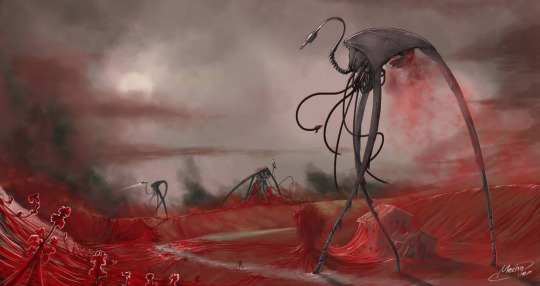
The Red Weed by Mechagen_Deviant Art_
The Martians bring with them a red weed that pretty much overtakes the landscape. It’s not clear whether they deliberately planted the weed or if it accidentally hatched a ride on their cylinders, got into the earth ecosystem and then proliferated.
And speaking of the differences between the life on Mars and terrestrial life, I may allude here to the curious suggestions of the red weed.
Apparently the vegetable kingdom in Mars, instead of having green for a dominant colour, is of a vivid blood-red tint. At any rate, the seeds which the Martians (intentionally or accidentally) brought with them gave rise in all cases to red-coloured growths. Only that known popularly as the red weed, however, gained any footing in competition with terrestrial forms. The red creeper was quite a transitory growth, and few people have seen it growing. For a time, however, the red weed grew with astonishing vigour and luxuriance. It “spread up the sides of the pit by the third or fourth day of our imprisonment, and its cactus-like branches formed a carmine fringe to the edges of our triangular window. And afterwards I found it broadcast throughout the country, and especially wherever there was a stream of water.”
The War of the Worlds: What We Saw from the Ruined House
As he has woven the story of the Martians so indelibly into Dany’s arc of ASOIAF, one would expect that George has also included something like the iconic red weed in his story and that it would be associated with Dany. And low and behold, he has done just that as Jorah describes to Dany how the Dothraki Sea looks at certain times of the year.
It was a sea, Dany thought. Past here, there were no hills, no mountains, no trees nor cities nor roads, only the endless grasses, the tall blades rippling like waves when the winds blew. "It's so green," she said.
"Here and now," Ser Jorah agreed. "You ought to see it when it blooms, all dark red flowers from horizon to horizon, like a sea of blood. Come the dry season, and the world turns the color of old bronze.
A Game of thrones, Daenerys III
It’s funny that George, describes the dark red flowers of his story like a sea of blood because Wells does something similar in his. He doesn’t specifically call it a sea, but he associates it with blood in a different way.
My first action coming to this water was, of course, to slake my thirst. I drank a great deal of it and, moved by an impulse, gnawed some fronds of red weed; but they were watery, and had a sickly, metallic taste.
The War of the Worlds: The Work of Fifteen Days
Blood of course tastes metallic because of its iron rich hemoglobin content, and so when Wells describes the red weed as tasting like metal, he wants you to think of blood.
Blood is another way that red as a motif plays an important role in the story. Like the many references to fire and black smoke from Martian weapons, Wells has numerous scenes where blood is heavily featured throughout the text.
The narrator often comes across the aftereffects of bloody scenes; people are often shown injured or getting into fights where they bleed; or in a blood rage as they fight each other for the scraps of survival. It’s to show that underneath the humans are not that different from the Martians.
However, it’s also to highlight the main reason the Martian’s came to earth. They invaded because they were looking for a new food source. Just like Dany and her followers in the Red Waste, theirs was depleted on Mars. And they found it in human blood.
They did not eat, much less digest. Instead, they took the fresh living blood of other creatures, and injected it into their own veins. I have myself seen this being done, as I shall mention in its place. But, squeamish as I may seem, I cannot bring myself to describe what I could not endure even to continue watching. Let it suffice to say, blood obtained from a still living animal, in most cases from a human being, was run directly by means of a little pipette into the recipient canal….
The War of the Worlds: What We Saw from the Ruined House
Red also appears in some trees the narrator encounters. There is a that while much smaller in nature than the Wall in ASOIAF, the narrator finds difficult to cross. When he does, he encounters some trees that are overgrown by the Martian red weed that has overtaken the land. The description of the trees as he walks underneath them can’t help but make one think of the weirwoods.
In the direction away from the pit I saw, beyond a red-covered wall, a patch of garden ground unburied. This gave me a hint, and I went knee-deep, and sometimes neck-deep, in the red weed. The density of the weed gave me a reassuring sense of hiding.
The wall was some six feet high, and when I attempted to clamber it I found I could not lift my feet to the crest. So I went along by the side of it, and came to a corner and a rockwork that enabled me to get to the top, and tumble into the garden I coveted.
Here I found some young onions, a couple of gladiolus bulbs, and a quantity of immature carrots, all of which I secured, and, scrambling over a ruined wall, went on my way through scarlet and crimson trees towards Kew—it was like walking through an avenue of gigantic blood-drops—possessed with two ideas: to get more food, and to limp, as soon and as far as my strength permitted, out of this accursed unearthly region of the pit.
The War of the Worlds: The Work of Fifteen Days
As I said, red is one of the most important motifs in TWOTW, and it is meant to signify danger from the Martians. It usually heralds their arrival or indicates their presence in the vicinity. There is the fire and blood, and red weed that I’ve already discussed, but red also appears symbolically in lights.
OF RED DOORS AND LEMON TREES
When the announcement is made that the Martians have arrived in London, a red light shines in from outside on to the ceiling of the room of the narrator’s brother. A couple of times, the narrator also sees red searchlights and a red glow in the vicinity where the Martians are located. Red is a warning both in TWOTW and in ASOIAF, which brings me to Dany’s red door.
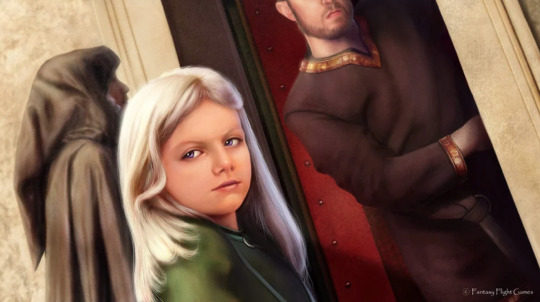
Credit: Tiziano Baracchi. © Fantasy Flight Games...via Deviant Art
All that Daenerys wanted back was the big house with the red door, the lemon tree outside her window, the childhood she had never known.
A Game of Thrones, Daenerys I
For Dany, this house with the red door represents a lost childhood and a time when she was happy. The longing to find this house with the red door is palpable throughout her arc. However, while on this surface, this seems like simply the dream of a lost and hurt child, I think that it and its color represent more.
As with Wells use of red in his story and George’s use of it in the house color of the Targaryen, I think Dany’s door being red is a warning to the reader to beware…that there is more to this symbolism than meets the eye. On a Watsonian level, Dany’s red door is also a warning to her about the danger she represents to the world of Planetos. Let’s dig in.
A few years ago, I wrote a thread on Twitter where I broke down what I think Dany’s red door means. I still hold to this theory and so I’ll copy and paste here with just a few minor corrections.
Why did George make the symbol of Dany's quest for home a red door? Well, aside from symbolically using red as a similar motif as Wells in TWOTW, I think it ties into the biblical story of the Passover. It’s the story of the world’s first known symbolic red door and you can read about it below.
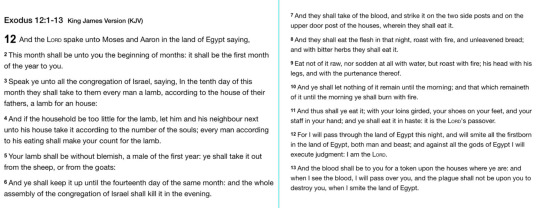
I should mention that I'm Episcopalian and the red door on our church is what made me associate Dany's door with the religious aspect of the biblical Passover. Red doors are also used on most Catholic Churches.
Red on church doors is supposed to represent a place of sanctuary. However, this is often not the case. The church and its priest not providing sanctuary is also a theme in TWOTW, but that’s a topic for another essay. My point is that George is a lapse Catholic and I’m sure he’s aware of the symbolism behind red doors and that institutional religion is often not a sanctuary.
Keeping the story of the Passover you just read in mind, what might it symbolically imply about Dany's arc and her quest for the red door? And why did dream turn into a nightmare the one time in the story she made it behind the door.
She could smell home, she could see it, there, just beyond that door, green fields and great stone houses and arms to keep her warm, there. She threw open the door.
“… the dragon …”
And saw her brother Rhaegar, mounted on a stallion as black as his armor. Fire glimmered red through the narrow eye slit of his helm. “The last dragon,” Ser Jorah’s voice whispered faintly. “The last, the last.” Dany lifted his polished black visor. The face within was her own.
After that, for a long time, there was only the pain, the fire within her, and the whisperings of stars.
She woke to the taste of ashes.
A Game of Thrones, Daenerys IX
Note George’s consistent use of black with red fire to echo both the Martian black smoke and Drogon’s flame. Based on the biblical scripture, to make it behind the red door is to be protected from the Lord's vengeance. He sent the angel of death during the night to kill all the first born of Egypt...be they people or animals. Only his people who obeyed his command to mark their door with the blood of a lamb no older than a year were protected when the angel of death came. The angel passed them over. The red door in this instance thus symbolizes protection.
However, not in the case of Dany. The protection of the red door is not available to her. And sadly, it probably never was. At least it won’t if Quaithe has her way. She emphasizes it in this and other dreams that she sends the dragon queen. Dany is the angel of death who does not belong behind the red door with the populace.
The only time Dany makes it behind the door, it occurs in her dreams, and it becomes a nightmare. She opens Rhaegar’s helm and sees not her brother, but herself. This should be a happy moment. She’s made it to home and behind the red door, where she is supposed to be safe, but of course, it’s not.
She is the angel of death and thus her being behind the red door indicates that she is a threat to the humans. Thus, her dream becomes a nightmare that foreshadows her future arc. It’s why she wakes to the taste of ashes.
But it was not the plains Dany saw then. It was King's Landing and the great Red Keep that Aegon the Conqueror had built. It was Dragonstone where she had been born. In her mind's eye they burned with a thousand lights, a fire blazing in every window. In her mind's eye, all the doors were red.
A Game of Thrones, Daenerys III
On the surface, longing for Kings Landing is just that, a longing for the home of her recent ancestors...a place she can call home. However, underneath, it maybe foreshadowing something much darker...potentially her burning of Kings Landing as on the show.
Dany’s red door and her "wake the dragon dream" have always been a signpost indicating where her story was going. The red door was never about home for her. Sadly, it’s just the opposite.
Dany thinks of herself as a god when flying Drogon in her last chapter of ADWD and so in a way, she is also the Lord sending the angel of death...in this case, Drogon among the populace.
By the way, George writes Drogon as "passing over" but Dany called him back to use him to bring the Dothraki to heel. Left alone to run wild, Drogon would have killed animals and some humans but for food only. It is in Dany’s hands, as was the case with past Targaryens and dragon lords that the beasts become weapons of mass destruction.
Thrice that day she caught sight of Drogon. Once he was so far off that he might have been an eagle, slipping in and out of distant clouds, but Dany knew the look of him by now, even when he was no more than a speck. The second time he passed before the sun, his black wings spread, and the world darkened. The last time he flew right above her, so close she could hear the sound of his wings.
A Dance with Dragons, Daenerys X
Later in the chapter after hearing Quaithe voice again in the stars, she decides to follow the shadowbinder’s advice and accept her dragon heritage.
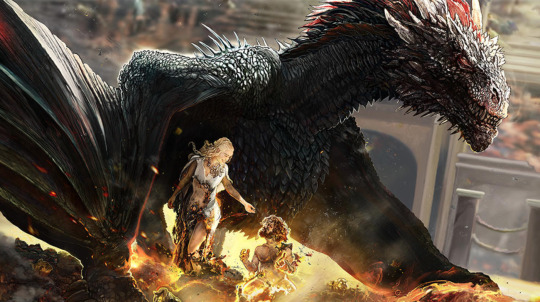
DanceOfDragons_by_ertacaltinoz_DeviantArt
Dany watched him go. When the sound of his hooves had faded away to silence, she began to shout. She called until her voice was hoarse … and Drogon came, snorting plumes of smoke. The grass bowed down before him. Dany leapt onto his back. She stank of blood and sweat and fear, but none of that mattered. “To go forward I must go back,” she said. Her bare legs tightened around the dragon’s neck. She kicked him, and Drogon threw himself into the sky. Her whip was gone, so she used her hands and feet and turned him north by east, the way the scout had gone. Drogon went willingly enough; perhaps he smelled the rider’s fear.
A Dance with Dragons - Daenerys X
Dany calls Drogon back to her and claims her dragon identity and he recognizes this change. Thus, she no longer needs a whip to control him. He now goes where she wants.
So, if Dany’s red door is meant to be seen as a warning, is it real or just a symbolic figment of her imagination. I think the answer is yes, it is real, but it also potentially a figment. What do I mean? Well, let’s first determine where the house with the red door is located.
I’m going to be as short as possible in this section as this chapter is already overlong. The topic of the red door probably deserves its own essay, but I don’t have the time to write it. There are also a couple of other important points about the influence of TWOTW on the story that I want to get to…including a brief discussion of Euron.
For years, the location of the house with the red door has been a hot topic of conversation in the fandom because, Dany says the house was in Braavos. The confusion arises because in her memory, Dany also remembers a lemon tree growing outside her window. The problem with this memory is that lemon trees and trees in general do not grow in the stone city of Braavos. I’m not going to go into the reasons why as most anyone who has read the books already know the answer, but the basic reason is a lack of irrigated water.
Some sides of the fandom have proposed that yes, Dany was raised in Braavos…at the Palace of the Sealord. He is rich and is said by Syrio Florel among others to have exotic creatures walking the grounds of his estate. Thus, if anyone resident could be said to be able to afford to have an irrigated system to channel water from the canals, it would be the Sealord. Thus, maybe it’s possible that Dany is remembering a house on the Sealord’s estate. Or maybe not.
Doran Martell also tells his daughter Arianne that she was promised to Dany’s brother Viserys as bride. An agreement signed and witness by Oberyn for House Martell and the Sealord as representative for Viserys. There seems to be no reason for Doran to lie about this story, and it fits with his tendency to play the long game. The Sealord also never leaves Braavos, and so, if such a pact was signed, it must have happened in that city and Dany and Viserys must have resided there. If not, why would the Sealord bear witness. This also supports the theory that Dany is remembering the Sealord’s house. But then again, maybe not.
Another popular option proposed by fans is that Dany was hidden away and raised in Dorne and that’s where the pact was signed. After all, it’s established on multiple ocassions in the text that Dorne is where lemon trees grow. It’s mentioned so often that I see it as one of George’s shiny apples. And by that, I mean that he hides the truth in plain sight and then by sleight of hand, makes the reader look in another direction. There are a lot of shiny apples in the text, and one day, I may write an essay about them.
I say that Dorne and the lemon trees that grow there are a shiny apple because I think that Dany was raised exactly where she says she was…in Braavos. Only, I don’t think that it was at the Sealord’s Palace. If not there, the question then becomes where?
Well, I think that the answer can be found in Dany’s dreams and the one constant other than Jorah, and her Dothraki khalasar that have been with her throughout her story thus far…Quaithe, the shadowbinder from Asshai. Quaithe is not always there with Dany in person, but her presence is always felt.
In AGOT, the stars whisper to Dany during her wake the dragon dream as I showed in the passage I posted above. We don’t know then that it’s Quaithe but we start getting an inkling that she will have an important role to play in Dany’s story when she shows up in person in A Clash of Kings.
The woman in the lacquered wooden mask said in the Common Tongue of the Seven Kingdoms, "I am Quaithe of the Shadow. We come seeking dragons."
"Seek no more," Daenerys Targaryen told them. "You have found them."
______
Last of the three seekers to depart was Quaithe the shadowbinder. From her Dany received only a warning. "Beware," the woman in the red lacquer mask said.
"Of whom?"
"Of all. They shall come day and night to see the wonder that has been born again into the world, and when they see they shall lust. For dragons are fire made flesh, and fire is power."
When Quaithe too was gone, Ser Jorah said, "She speaks truly, my queen . . . though I like her no more than the others."
A Clash of Kings, Daenerys II
Quaithe turns up again a little later in ACOK, this time with a warning and a bit of cryptic advice for Dany.
“The woman took a step backward. “You must leave this city soon, Daenerys Targaryen, or you will never be permitted to leave it at all.”
Dany’s wrist still tingled where Quaithe had touched her. “Where would you have me go?” she asked.
“To go north, you must journey south. To reach the west, you must go east. To go forward you must go back, and to touch the light you must pass beneath the shadow.”
Asshai, Dany thought.
A Clash of Kings, Daenerys III
By the way, I think that Quaithe’s riddle is another of George’s shiny apple, and I’ll discuss why if I ever write that essay on the topic.
Dany next has an encounter with Quaithe in A Storm of Sword, only this time she is not there in person, but instead communicates with Dany via a glass candle and again peppers her with the cryptic riddle.
She woke suddenly in the darkness of her cabin, still flush with triumph. Balerion seemed to wake with her, and she heard the faint creak of wood, water lapping against the hull, a footfall on the deck above her head. And something else.
Someone was in the cabin with her.
“Irri? Jhiqui? Where are you?” Her handmaids did not respond. It was too black to see, but she could hear them breathing. “Jorah, is that you?”
“They sleep,” a woman said. “They all sleep.” The voice was very close. “Even dragons must sleep.”
She is standing over me. “Who’s there?” Dany peered into the darkness. She thought she could see a shadow, the faintest outline of a shape. “What do you want to me?”
“Remember. To go north, you must journey south. To reach the west, you must go east. To go forward you must go back, and to touch the light you must pass beneath the shadow.”
“Quaithe?” Dany sprung from the bed and threw open the door. Pale yellow lantern light flooded the cabin, and Irri and Jhiqui sat up sleepily.
A Storm of Swords, Daenerys III
She next has two encounters with Quaithe is in ADWD.
“They sleep,” came the answer.
A woman stood under the persimmon tree, clad in a hooded robe that brushed the grass. Beneath the hood, her face seemed hard and shiny. She is wearing a mask, Dany knew, a wooden mask finished in dark red lacquer. “Quaithe? Am I dreaming?” She pinched her ear and winced at the pain. “I dreamt of you on Balerion, when first we came to Astapor.”
“You did not dream. Then or now.”
“What are you doing here? How did you get past my guards?”
“I came another way. Your guards never saw me.”
“If I call out, they will kill you.”
“They will swear to you that I am not here.”
“Are you here?”
“No. Hear me, Daenerys Targaryen. The glass candles are burning.
________
“If you have some warning for me, speak plainly. What do you want of me, Quaithe?”
Moonlight shone in the woman’s eyes. “To show you the way.”
A Dance with Dragon, Daenerys II
Does it seem as if Quaithe wants Dany to trust only her? It does to me.
Dany’s final encounter with Quaithe happens in her last chapter of ADWD. And it is here that we get confirmation that she has always been the whisperer of stars in Dany’s dreams.
She dreamed. All her cares fell away from her, and all her pains as well, and she seemed to float upward into the sky. She was flying once again, spinning, laughing, dancing, as the stars wheeled around her and whispered secrets in her ear. "To go north, you must journey south. To reach the west, you must go east. To go forward, you must go back. To touch the light you must pass beneath the shadow."
"Quaithe?" Dany called. "Where are you, Quaithe?"
Then she saw. Her mask is made of starlight.
"Remember who you are, Daenerys," the stars whispered in a woman's voice. "The dragons know. Do you?"
A Dance with Dragons, Daenerys X
Dany perceives Quaithe as speaking to her via the stars, whispering as it were. Thus, we realize that when the stars whispered to her during her wake the dragon dream back in A Game of Thrones, it was likely Quaithe at that time as well, communicating with Dany via a glass candle.
"What feeds the flame?" asked Sam.
"What feeds a dragon's fire?" Marwyn seated himself upon a stool. "All Valyrian sorcery was rooted in blood or fire. The sorcerers of the Freehold could see across mountains, seas, and deserts with one of these glass candles. They could enter a man's dreams and give him visions, and speak to one another half a world apart, seated before their candles. Do you think that might be useful, Slayer?"
"We would have no more need of ravens."
A Feast for Crows, Sam V
I fully expect to discover that Marwyn knows Quaithe. After all, we know from Miri Maz Duur that he was in Asshai. He is the one who taught her about the human body. I suspect that Quaithe in turn taught Marwyn, and a lot more than just the secrets of the body. After all, Quaithe is a shadowbinder from Asshai, where dragons are said to come from and which others in the fandom have proposed, may have been the ancient capital of the Great Empire of the Dawn. A theory that I endorse.
In Dany’s “wake the dragon” dream, Quaithe sends her a vision of her ancestors. Why?
Ghosts lined the hallway, dressed in the faded raiment of kings. In their hands were swords of pale fire. They had hair of silver and hair of gold and hair of platinum white, and their eyes were opal and amethyst, tourmaline and jade. "Faster," they cried, "faster, faster." She raced, her feet melting the stone wherever they touched. "Faster!" the ghosts cried as one, and she screamed and threw herself forward. A great knife of pain ripped down her back, and she felt her skin tear open and smelled the stench of burning blood and saw the shadow of wings. And Daenerys Targaryen flew.
A Game of Thrones, Daenerys IX
George gave us a bit more history on these ancient Targaryen ancestors when he dropped this ditty in TWOIAF history book.
Dominion over mankind then passed to his eldest son, who was known as the Pearl Emperor and ruled for a thousand years. The Jade Emperor, the Tourmaline Emperor, the Onyx Emperor, the Topaz Emperor, and the Opal Emperor followed in turn, each reigning for centuries...yet every reign was shorter and more troubled than the one preceding it, for wild men and baleful beasts pressed at the borders of the Great Empire, lesser kings grew prideful and rebellious, and the common people gave themselves over to avarice, envy, lust, murder, incest, gluttony, and sloth.
When the daughter of the Opal Emperor succeeded him as the Amethyst Empress, her envious younger brother cast her down and slew her, proclaiming himself the Bloodstone Emperor and beginning a reign of terror. He practiced dark arts, torture, and necromancy, enslaved his people, took a tiger-woman for his bride, feasted on human flesh, and cast down the true gods to worship a black stone that had fallen from the sky. (Many scholars count the Bloodstone Emperor as the first High Priest of the sinister Church of Starry Wisdom, which persists to this day in many port cities throughout the known world).
The World of Ice and Fire, The Bones – Beyond YiTi
Based on the similarity in the descriptions of the ancient people from the GEOTD to the ancestors in Dany’s vision, the fandom, I think correctly assumed that they are one and the same. I propose that their appearance in Dany’s vision isn’t just about a generic ancestral line, but rather to clue us in that Targaryen genetic blood line can be traced all the way back to the Bloodstone Emperor.
In fact, I think that the Blackfyre is the first Valyrian steel blade. It’s the red “sword of heroes” Melisandre constantly references, and its heritage can be traced all the way back to the Bloodstone Emperor. The blood of the Amethyst Empress or Nissa Nissa, if you want to call her that went into the forging of that sword. There is more to it than just the forging of the sword as it also had to do with the BE’s attempt to gain access to the weirwoods, but I think that Blackfyre is his sword, and it has been passed down through the Targaryen line since then.
All the dark arts referenced in the history books are still practiced in the Shadowlands from where Quaithe hails. Quaithe whispering to Dany through the stars, strongly suggests as others have proposed that she is a member of the Church of Starry Wisdom originally started by the BE. I also think that the church has been keeping a close on and watching over the Targs through the many generations since the height of the GEOTD, and it was a member of the church who sent the dreams to Daenys the Dreamer about the coming fall of Valyria.
I would not be surprised to discover that the church was somehow involved with what happened in Valyria. I think that their goal is again to attempt the deepest of the dark arts, and Dany is the unknowing guinea pig to help Quaithe and other senior members of the church achieve their goals.
Also, Dany’s ability to hear the whispering through the stars, suggests that she may have been unknowingly exposed to the church’s trainings. And I don’t mean that she’s literally hearing thoughts through the stars. It’s about symbolism and her knowing to associate Quaithe with them.
Therefore, I proposed that the house with the red door she remembers, is the Church of Starry Wisdom in Braavos. The red door is either the entrance door or on a building on the church’s estate. It was there that Dany picked up some unknowing little knowledge about scrying to the stars…maybe even by using a glass candle.
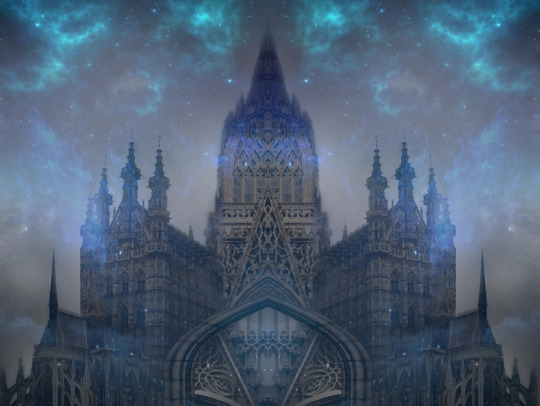
Church of Starry Wisdom by Cyprus-1 - Deviant Art
As I stated up thread, red doors are often associated with churches. However, we don’t know the color of the one on the door of the COSW in Braavos. The only reference we have to it in the text is from Arya when she walks by as Blind Beth.
As she made her way past the temples, she could hear the acolytes of the Cult of Starry Wisdom atop their scrying tower, singing to the evening stars.
A Dance with Dragons, The Blind Girl
The door to the church could be red. We don’t know. However, I don’t think that it is. I think that the red door that Dany remembers is an interior one…behind the main entrance.
She was walking down a long hall beneath high stone arches. She could not look behind her, must not look behind her. There was a door ahead of her, tiny with distance, but even from afar, she saw that it was painted red. She walked faster, and her bare feet left bloody footprints on the stone.
A Game of Thrones, Daenerys IX
Halls are interior walkways and so the fact that she is in one with stone arches suggests that she is in some type of courtyard and the red door of her memory opens out from there. This still leaves the question of the lemon tree, which after all, do not grow in Braavos.
If she did stay in Braavos and there are no lemon trees in the city, then how do we explain the mystery. My answer is that while I think that Dany stayed at the Church of Starry Wisdom while in Braavos, the lemon tree, and quite possibly the house with the red door are things of the past that Dany viewed through a glass candle, possibly even from as far back as ancient Asshai when it was a robust seafaring port city. After all, we don’t yet know the full magical aspects of the candles.
Another explanation for the missing lemon tree and red door is that the two are simply metaphors and George is playing with the idea of the golden apples from the Garden of Hesperides. There are many myths of the golden apples in many different cultures including Greek where they play into the myths of Hercules, Hera, Atlanta, and Paris of Troy and the Trojan War. There is even an Irish myth of the golden apple branch.
In the Hercules myth, the golden apples grown in the Garden of Hesperides, sacred to Hera. The apples and the garden were guarded by the dragon Ladon. Modern scholars think that the golden apples were actually a citrus fruit...either an orange or a lemon. George might be playing with the idea of them being lemons.
I mention this of course because of the dragon connection but also because the apples in most of the myths, granted immortality or access to the underworld, a theme which is strongly at play in ASOIAF.
George also seems to be playing with the idea of the golden apples in the ancient myth of one of the daughters of Garth Greenhand, Rowan Gold-Tree...
who was so bereft when her lover left her for a rich rival that she wrapped an apple in her golden hair, planted it upon a hill, and grew a tree whose bark and leaves and fruit were gleaming yellow gold, and to whose daughters the Rowans of Goldengrove trace their roots.
The World of Ice and Fire, The Reach: Garth Greenhand
The thing is that if George is symbolically playing with this idea and Dany is supposed to be the dragon guarding the red door...possibly a symbolic access point to the underworld, she abandoned or was force to abandon her post, and so we will have to see what that potentially means.
And there you have it. My theory about Dany’s possible explanations for Danys infamous red door with the lemon tree outside the window. Tinfoil? Possibly…only maybe not.
I’ve discussed in this and the previous two chapters the many ways in which George compares his dragons to Wells’ Martians. However, there is one other comparison that Wells makes in his story that George echoes in his that I want to mention. Only this time, the comparison is not to Dany and her dragons but to another character.
OF DANY AND EURON
And so, I will wind things down and leave you with these final passages and how they play into the arc of this character from ASOIAF. First, we will again briefly revisit the red weed and black smoke.
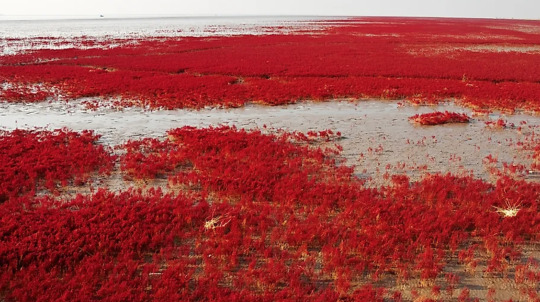
Panjin Red Beach marsh landscape_World Atlas
At Putney, as I afterwards saw, the bridge was almost lost in a tangle of this weed, and at Richmond, too, the Thames water poured in a broad and shallow stream across the meadows of Hampton and Twickenham. As the water spread the weed followed them, until the ruined villas of the Thames valley were for a time lost in this red swamp, whose margin I explored, and much of the desolation the Martians had caused was concealed.”
The War of the Worlds: The Work of Fifteen Days
________
“About one o’clock in the afternoon the thinning remnant of a cloud of the black vapour appeared between the arches of Blackfriars Bridge. At that the Pool became a scene of mad confusion, fighting, and collision, and for some time a multitude of boats and barges jammed in the northern arch of the Tower Bridge, and the sailors and lightermen had to fight savagely against the people who swarmed upon them from the riverfront. People were actually clambering down the piers of the bridge from above.
When, an hour later, a Martian appeared beyond the Clock Tower and waded down the river, nothing but wreckage floated above Limehouse.”
The War of the Worlds: The Thunder Child
______

A Martian fighting-machine battling with HMS Thunder Child. (Corréa, 1906)
“About a couple of miles out lay an ironclad, very low in the water, almost, to my brother’s perception, like a water-logged ship. This was the ram Thunder Child. It was the only warship in sight, but far away to the right over the smooth surface of the sea—for that day there was a dead calm—lay a serpent of black smoke to mark the next ironclads of the Channel Fleet, which hovered in an extended line, steam up and “ready for action, across the Thames estuary during the course of the Martian conquest, vigilant and yet powerless to prevent it.”
The War of the Worlds: The Exodus from London
Consider now this conversation between Jon and Melisandre.
"We've had a raven from Ser Denys Mallister at the Shadow Tower," Jon Snow told her. "His men have seen fires in the mountains on the far side of the Gorge. Wildlings massing, Ser Denys believes. He thinks they are going to try to force the Bridge of Skulls again."
"Some may." Could the skulls in her vision have signified this bridge? Somehow Melisandre did not think so. "If it comes, that attack will be no more than a diversion. I saw towers by the sea, submerged beneath a black and bloody tide. That is where the heaviest blow will fall."
A Dance with Dragons - Melisandre I
In the excerpt from TWOTW, we see that the bloody tide of the Martian red weed literally causes the Thames to flood London, which at the time was the premier English city of learning. London with its famous Tower Bridge and its two towers. We also see that the black smoke and fires from the Martian Heat Ray are destroying the British Fleet.
Juxtaposed those passages with Melisandre vision from ASOIAF. Mels has a vision of a symbolic bloody tide submerging towers by the sea. Her bloody tide echoes that of the red weed and black smoke flooding London and its countryside.
In ASOIAF, all evidence suggests that George’s version of the bloody tide will be caused by Euron as he and the Ironfleet attack Oldtown, the premier city of learning in Westeros and home to two major towers…the Hightower and the Citadel. Poor Quentyn famously broke down this theory in his Eldritch Apocalypse essay.
The rivers will be red with blood after the Ironborn attack, and any of the Redwyne fleet that were not previously destroyed, and or others put into play by Tyrells or Hightowers will be as defenseless against the Ironfleet as the British Navy is shown to be against the Martians.
There is also the potential for a real flood if shards of meteors hit planetos as has been proposed by Lucifer Means Lightbringer. This echoes the flooding caused by the Martians because as I discussed in part one, the Martian cylinders were at first thought to be meteors.
The bloody tide is not the only comparison George makes in his story to Euron and the events in The War of the Worlds.

Illustration from original edition of HG Wells’s War of the Worlds, Public Domain
“Once a leash of thin black whips, like the arms of an octopus, flashed across the sunset and was immediately withdrawn, and afterwards a thin rod rose up, joint by joint, bearing at its apex a circular disk that spun with a wobbling motion. What could be going on there?”
The War of the Worlds: The Heat Ray
_______
“I talked with these soldiers for a time; I told them of my sight of the Martians on the previous evening. None of them had seen the Martians, and they had but the vaguest ideas of them, so that they plied me with questions.
“ ’Ain’t they got any necks, then?” said a third, abruptly—a little, contemplative, dark man, smoking a pipe.”
“I repeated my description.
“Octopuses,” said he, “that’s what I calls ’em. Talk about fishers of men—fighters of fish it is this time!”
The War of the Worlds: The Fighting Begins
Although this next excerpt has not yet officially appeared on the page, we learn about from George’s reading of an excerpt of The Winds of Winter at a convention, which fans such as Poor Quentyn and others recorded, transcribed, and shared with the rest of the fandom. Thanks guys!
The dreams were even worse the second time.
He saw the longships of the Ironborn adrift and burning on a boiling blood-red sea. He saw his brother on the Iron Throne again, but Euron was no longer human. He seemed more squid than man, a monster fathered by a kraken of the deep, his face a mass of writhing tentacles. Beside him stood a shadow in woman’s form, long and tall and terrible, her hands alive with pale white fire. Dwarves capered for their amusement, male and female, naked and misshapen, locked in carnal embrace, biting and tearing at each other as Euron and his mate laughed and laughed and laughed...
The Martians are compared to octopuses while Aeron views Euron as looking like a squid. Pretty much the same thing.
And what about the woman whose hands are alive with pale white fire. There has been much discussion in the fandom over who the woman might be with suggestions ranging from Dany to Cersei, to even Viserion as the dragon’s fire is pale white. As it is said that dragons can be both sexes, this theory assumes that Viserion is currently female.
Like dragons, the Martian’s have no discernable sex. However, unlike dragons who lay eggs, their procreation method seems to mimic that of flowers.
In the next place, wonderful as it seems in a sexual world, the Martians were absolutely without sex, and therefore without any of the tumultuous emotions that arise from that difference among men. A young Martian, there can now be no dispute, was really born upon earth during the war, and it was found attached to its parent, partially budded off, just as young lilybulbs bud off, or like the young animals in the fresh-water polyp.
The War of the Worlds: What We Saw from the Ruined House
I for one think the woman with hands with pale white flame is meant to represent Dany. While there is no female Martian, as I’ve discussed, the Targs and their dragons are heavily compared to the alien invaders and their fiery black smoke. And like the Martians, they bring fire and blood. Funnily enough, while there is no figure of a woman involved, there is a scene in TWOTW makes one think of the Euron excerpt. We get a hint that the woman with Euron is Dany in another of Melisandre’s memory of her vision.
“Visions danced before her, gold and scarlet, flickering, forming and melting and dissolving into one another, shapes strange and terrifying and seductive. She saw the eyeless faces again, staring out at her from sockets weeping blood. Then the towers by the sea, crumbling as the dark tide came sweeping over them, rising from the depths. Shadows in the shape of skulls, skulls that turned to mist, bodies locked together in lust, writhing and rolling and clawing. Through curtains of fire great winged shadows wheeled against a hard blue sky.”
A Dance with Dragons, Melisandre I
I’m not sure about the symbolic implication of the white fire in either instance, but the one with Euron does show George being consistent in echoing events in TWOTW. Let’s look at the passage in question.
The air was full of sound, a deafening and confusing conflict of noises—the clangorous din of the Martians, the crash of falling houses, the thud of trees, fences, sheds flashing into flame, and the crackling and roaring of fire. Dense black smoke was leaping up to mingle with the steam from the river, and as the Heat-Ray went to and fro over Weybridge its impact was marked by flashes of incandescent white, that gave place at once to a smoky dance of lurid flames. The nearer houses still stood intact, awaiting their fate, shadowy, faint, and pallid in the steam, with the fire behind them going to and fro.
The War of the Worlds
Dany represents the incandescent white fire, or in George’s parlay, the woman with hands of pale white fire.
Also, as I briefly discussed here, George has associated both Dany and Euron with storms for a reason. It gives them something in common and we the readers should wonder about this commonality. We should also ponder what might happen if these two storms merge and possibly generate a Fujiwhara Effect.
So, we come to the end of this series, that’s been 4 years in the writing. What are your thoughts? What do you think George writing Dany, the Targs and Euron like Martian Invaders will mean? Finally, what do you think of my red door theory…tinfoil? All thoughts welcome.
And yes, I will finish the Florian and Jonquil, and Dragon vs the Wolf series. I promise.
If you didn’t take my advice and read this chapter before reading the first two, you can go back and read them at the links below.
The War of the Worlds is a pretty short book…about 300 pages, and so if you want to read it for yourself to see other comparisons I didn’t include…and there are more, prices for the Apple e-book starts as low as $2.99. Or if you prefer a listen, check out the dulcet sounds of Robert from In Deep Geek as he reads the entire book on his second YouTube channel, The Well Told Tale.
PART ONE
PART TWO
GRRM’s ESSAY ON MARS
No doubt I will re-read and find numerous typos that I will have to go back to fix but here it is. Thanks for reading.
ETA 1/26/23...As expected, I found a few typos, which I fixed. I also added some sections header and a second quote from Melisandre’s visions pertaining to Dany and Euron.
#asoiaf#asoiaf meta#literary comparasion#war of the worlds#george rr martin#hg wells#daenerys targaryen#euron greyjoy#storm cloud meta#daenerys endgame#daenerys endgame analysis#asoiaf analysis#long meta#scr meta
20 notes
·
View notes
Text
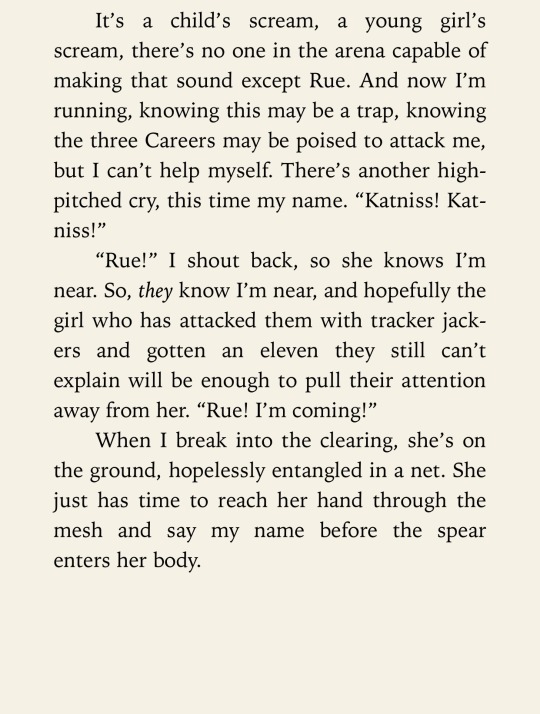

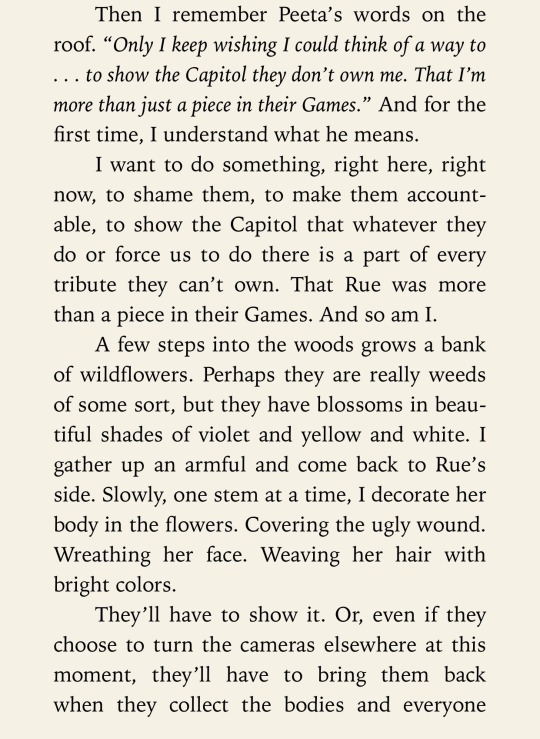
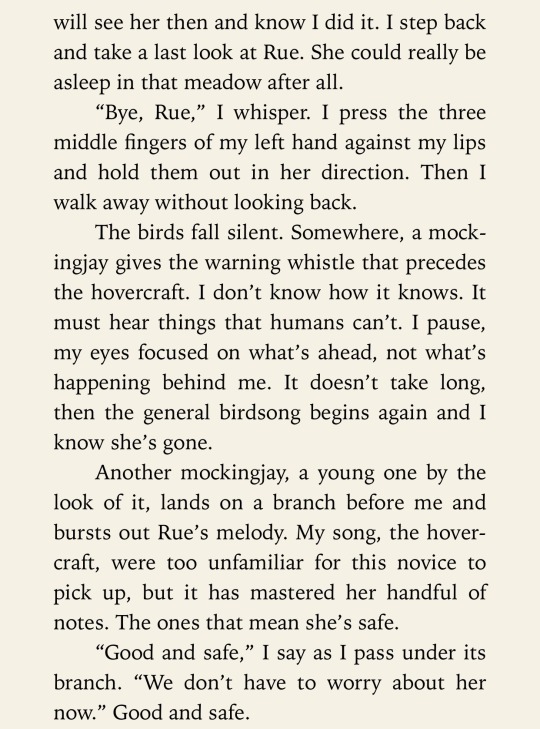
Katniss's first on-purpose kill is for revenge and her first on-purpose act against the Capitol is also for revenge and she will never encounter innocence again and the music of childhood is gone and I'm kicking and screaming and throwing up
11 notes
·
View notes
Text
SoH Rambles: Hashimoto
I think about SoH a lot, so take this tiny little micro analysis of Masa’s family, the Hashimoto’s!
I've always pictured Masa having a large immediate family, but idk if Devon confirmed that he only had one elder brother and sister (at least, guy Masa). Like, it's not completely totally clear to me lol. But for the sake of this headcanon, we’re just gonna roll with Masa being the youngest of three.
I like to imagine that Masa has a decently large extended family, but that all live dispersed across Hyuga. Because they keep mentioning the class and power of the Hashimoto family, I'm going to assume they're old money, got that generational wealth, know what I'm sayin? If Amaterasu is getting hitched (arranged marriage, I might add) to the fucking EMPEROR, then we know that their family branch is likely the most important and influential one, meaning Masa’s dad is the first-born and inheritor of the Hashimoto business and wealth, as well as the head of the family, if multiple branches of the family tree exist. Image is very important, as well as reputation. The eldest son, Tsukuyomi (which is actually rly funny bc in Japanese lore, Tsukuyomi and Amaterasu were the sun and moon gods, as well as their bro Susanoo, who -say it w me, kids- was the STORM/SEA GOD, aka LIGHTNING/HUNDER aka MASA’s PREFERRED ELEMENT OF CHOICE??? HELLO??? There better be a call back to this otherwise I'm gonna flip.) Anyway, Tsukuyomi would have lots of pressure and responsibilities as the heir to the Hashimoto family and business, Amaterasu serves as an alliance marker by marrying into another powerful house, blah blah. That leaves Masa as an outlier, with no real purpose but to marry into a good family to make more house alliances, but with their position as a shugenja a military career seems most beneficial. Sort of confirmed in Book 6 Ch 1, “Masashi’s path as a shugenja is ideal- and that brings...legitimacy to the Hashimoto. His father, while technically a Samurai, is among the most shrewd and powerful businessmen in Hyuga...”
The implication here is that despite being a lord, Hashimoto-san has no real military power (otherwise he'd be a high-ranking member of the Shogunate instead of being a samurai). Being a samurai implies that he belongs to a noble home, tying in the generational wealth thing. If he were just a merchant who made his own fortune then he wouldn’t be a samurai, bc he needs to either be born into a noble home, marry into one, or be adopted into one. Sure he could have married into a noble home, middle-class-turned-elite/upper-class type of thing, but it doesn't truly hold much weight with everything else we've been fed about this family. The Hashimoto name seems to hold much more power and influence in Hyuga than I imagine would be appropriate if Hashimoto were “new money”.
Hashimoto-san is a businessman, likely also the academic/scholarly type, and isn’t a particularly powerful samurai house. But stick your wizard *prodigy* child into the military? BOOM military power. That’s maybe part of the reason why they invest so much money into the academy (besides just investing bc their child attends classes duh), to make up for their shortcomings. And with Masa in the military, Hashimoto now has a finger in each sector of the country.
Tsuku-Business (implied to own/monopolize a “sector of the market”)
Amaterasu- Politics/Govt (goddamn EMPRESS??)
Masa- Military (and to a certain extent even religion/spirituality, if we consider the fact that shugenja is essentially harnessing spirits and shit)
My point with all of this?
Nothing. Nada. Idk what I'm even trying to say. This all started as me wanting to make fun little head canons and it turned into me realizing that the Hashimoto family is slowly integrating themselves into every aspect of Hyuga. Wouldn’t it be fun if they ended up being antagonists? I’d love that. Anyway thanks for coming to my tedtalk, I’m illiterate sue me.
#trying to post before the new chapter comes out#thoughts??#I rly like writing little analysis stuff on SoH#I actually have a lot more trapped in my sketch journal buuut a lot of them were either debunked or already proven which is lame to post ig#idk hope y’all enjoy!!#samurai of hyuga#soh#choice of games#hosted games#interactive fiction#devon connell#cog#hg#masashi hashimoto#ronin rambles#SoH analysis
2 notes
·
View notes
Text
0 notes
Text
Coming in January 2024, the second installment of my Socialist Cinema series:
#united front#communism#anticapitalism#socialism#socialist cinema#cinema#film#movies#film analysis#hg wells#things to come#futurism#futuristic#science fiction#sci fi
0 notes
Text
the influx of hg content because of the new movie … my brain so desperately wanting to talk about ryder’s hg verse … but lazy :))
#( tell me to shut up ; ooc. )#I love having people doing their lil analysis on characters#or the tiny details in the book — or talking about the book that#the new movie is based on ?? like now I want to read it too damn#anyways I love ryder’s hg verse & how I can let him be absolutely fucking feral
1 note
·
View note
Text
A defence of the Good Guy / Bad Boy love triangle
It is no secret that mainstream YA & NA fantasy gravitates towards an angsty love triangle. But is this trope's popularity due to vapid teenage vanity... or something far deeper?

Warning: in this post, I will be referencing: True Blood/The Southern Vampire Mysteries, Legendborn, A Court of Thorns and Roses, The Shadow and Bone Trilogy, Buffy the Vampire Slayer, The Hunger Games, Chilling Adventures of Sabrina, and The Vampire Diaries. Some minor spoilers, mostly relating to the romance side of things, may be involved.
I have stumbled across a bunch of articles lately analysing why love triangles are popular in YA and NA fiction - and all of them, in my opinion, missed the entire point.
Firstly, they focus entirely on the "love interests", while wilfully ignoring the fact that the romance element is often a subset of these stories, rather than the main focus (more on that later).
Secondly, these articles often attribute the appeal of the love triangle to "teenage vanity". They either directly state or imply that young women are drawn to the idea of "provoking" two men into a fight for their affection.

Look, I get it.
Or at least I get how a middle-aged man tap-tap-tapping away on his computer might draw that conclusion. Especially if the crux of his knowledge regarding female-centred fantasy rests on blog posts ripping apart Twilight.
But regardless, the fact remains that labelling YA love triangles as a conceited sexual fantasy is a gross over-simplification. Why? Because romance is rarely the point of the story. Instead, the love triangle is a vehicle through which the author complements and elevates the standard Hero's Journey plot beats.
To demonstrate this argument, I will go through each of the critical plot beats in the Hero's Journey. For each beat, I will demonstrate (with examples) how dual love interests can underscore the character development of the protagonist and highlight her emotional struggles during each stage.
The outline for this analysis will be as follows:
Introduction of the Female Protagonist / Refusal of the Call
Meet the Good Guy / Meeting the Mentor
Meet the Bad Boy / Tests, Allies, and Enemies
Death of Innocence / The Ordeal in the Abyss
Heartbreak / "Death" of the Mentor
Grief for Lost Innocence / Refusal of the Return
Self-Discovery / The Road Back Home
Female Protagonist Accepts Her New Self / Master of Two Worlds
For reference, here is a rough outline of the major plot beats in the Hero's Journey:
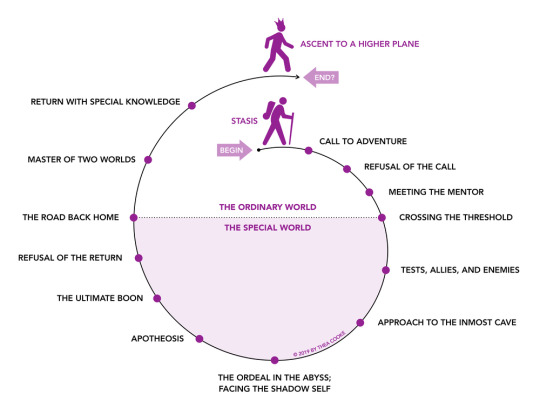
Alright. Time to rip apart some assumptions.
Let's go!
Introduction of the Female Protagonist
Refusal of the Call
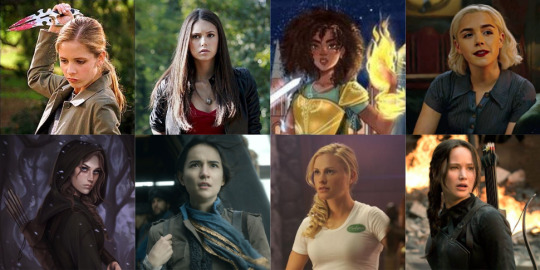
Mainstream fantasy love triangles almost always centre a female protagonist hence why people love to hate on them. The introduction of this protagonist generally follows your fairly standard Hero's Journey opening.
We meet the protagonist, usually a teenager or young woman, going about their "everyday life" in the ordinary world.
But then the Call to Adventure comes - sometimes referred to as the Inciting incident. For Feyre (ACOTAR), this moment is when she kills a wolf who turns out to be Fae. Or for Katniss (HG), her sister's name is drawn, prompting her to offer herself as a tribute instead.
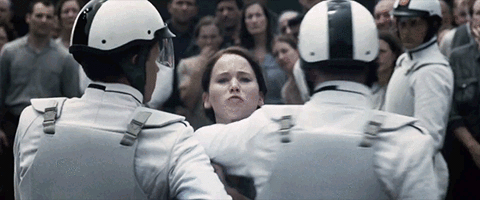
The Call to Adventure or Inciting Incident marks a point of no return - even though the protagonist might not realise it at the time. It is the moment when life as they know it ends. Afterwards, nothing will ever be the same, including the protagonist.
The following beat is usually the Refusal of the Call, where the protagonist resists any change coming their way. Buffy (BTVS), for example, wants to continue her life as a regular teenage girl instead of being burdened by the duties of being the Slayer. Similarly, Sabrina (TCAOS) is hesitant to participate in the dark baptism, scared of its implications for her ties to the mortal world.
But for the plot to move forward, something or someone needs to prompt the protagonist to leave the "ordinary" world behind - and in turn, take those first few tentative steps into the "special" world (unknown).
Enter...
Meeting the Good Guy
Meeting the Mentor

The Mentor doesn't always have to be an Obi-Wan-style character who teaches the protagonist everything they know about lightsabers. In its simplest form, the Mentor archetype is a guide. Someone who takes the protagonist by the hand, either literally or metaphorically, and leads them from the ordinary world into the special one.
This transition is known as Crossing the Threshold and it is the beat that marks the shift from Act I to Act II.
Now, there is a good reason why the Meeting the Mentor plot beat often serves as a precursor to Crossing the Threshold. And no, it isn't because the protagonist is incapable of doing anything by themselves.
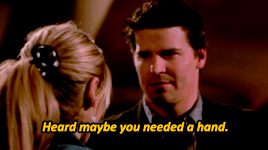
Instead, the Mentor character is often employed to explain how this new world works to both the protagonist and the reader alike.
Through the protagonist interacting with a "guide", the rules and systems of the new world can be revealed through dialogue and action, rather than excessive exposition and info-dumping.
And this is where the "good guy" as a Mentor character stand-in comes into play. His arrival serves the dual purpose of propelling the protagonist into the Crossing the Threshold beat and guiding her once she does.
For example, Sookie's budding romance with Bill is what introduces her (and us) to the Charlene Harris's world of vampires in True Blood. Or, in Tamlin's case, he takes his role in "helping" Feyre to cross the threshold quite literally and abducts her, forcing her to leave the human world behind in place of the world of Fae.
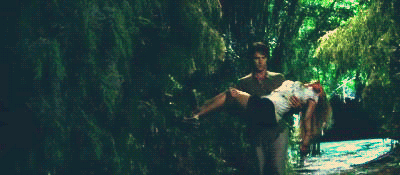
Now, there are quite a few exceptions to this good guy/mentor rule and they generally occur when the good guy is a childhood friend or sweetheart. Examples include Harvey (TCAOS), Gale (HG), and Malyen (SAB).
When this happens, the good guy often provides the protagonist with a much-needed link to her previous life and/or the ordinary world. He takes on more of a "grounding" role, rather than a guiding one.
But regardless, what these good guys have in common is a fairly standard set of traits. They are protective, have a strong moral compass, and are incredibly loyal to the protagonist.
Furthermore, they are almost always the protagonist's "first love". They offer her the emotional support she needs in order to move forward by making her feel less alone in the world.

Regardless of whether the good guy is a childhood friend or a mentor-like character, his relationship with the protagonist usually marks a time of both innocence and self-discovery. He is a source of love and companionship while the protagonist takes those first few tentative steps into the unknown.
Meeting the Bad Boy
Tests, Allies, and Enemies
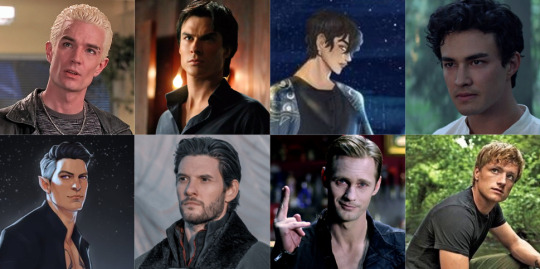
The Hero's Journey is, at its essence, a Bildungsroman-like story. Or at least it is in the YA/NA genres. It is a coming-of-age tale, with Crossing the Threshold being a symbol for leaving the child behind in order to discover the adult that awaits.
What follows is a collection of plot beats known as Tests, Allies, and Enemies. This stage of the story is often fraught with missteps and small triumphs, good times and bad times - much the same as adolescence.
And this is where the bad boy comes in.

Sometimes the bad boy manifests as an enemy who the protagonist must face in some kind of test like Spike to Buffy. Other times, he presents as a Temptation beat, like the Darkling does to Alina (SAB), trying to lure the protagonist away from their path.
But regardless of how he makes his entrance, the initial purpose of the bad boy is almost always to bring the protagonist face-to-face with the dangers of this new world.
For example, through Eric, Sookie realises that not all vampires are polite and restrained like Bill. Similarly, Feyre's first encounters with Rhysand show her an even darker side to the Fae.
Even bad boys who are not outright evil still tend to behave in a way that the protagonist finds confronting, like Peeta (HG), whose ruthlessly practical survival tactics disturb the very moral Katniss.
In this sense, the bad boy fashions himself into a symbol of the harsh realities of adulthood. Much as a child might find their first encounter with the cruelty of the world shocking, the protagonist is shocked and appalled by the bad boy.
We're not in Kansas anymore, Dorothy.

However, it is important to note that the bad boy is usually just one component of the beats involved in the Tests, Allies, and Enemies section. Again, this ties in with my argument that these stories are a Hero's Journey first - with the love triangle simply underscoring that fact.
The friendships that Buffy forms with Willow and Xander are shown to be her two most enduring relationships, while her love interests come and go. In Legendborn, Bree's quest to learn the truth about her mother's death has nothing to do with romance at all. And Sabrina's rivalry-to-friendship arc with Prudence gets significant screen time across multiple episodes and seasons.

During the Tests, Allies, and Enemies stage, the protagonist is usually starting to come into her own. She faces challenges, forms friendships, and encounters enemies. And yes, with love triangles there's usually some lust and romance thrown in there, too.
But the main focus of this stage is that the protagonist is starting to learn who she is. She is becoming more and more powerful with each setback and triumph.
The Death of Innocence
The Ordeal in the Abyss

The Ordeal into the Abyss, also known as The Belly of the Whale, is a plot beat where the protagonist encounters their greatest test thus far.
Rather than this beat being the climax of the story, The Ordeal is generally a challenge that the protagonist must face before the final confrontation or battle - and they must do so alone. It sees them hitting rock bottom and coming face-to-face with their greatest fear, whatever that may be.
This plot beat is a transformative one. It forever changes the protagonist and readies them for the final battle ahead. It is a death of innocence. The moment when the "girl" becomes the "woman", so to speak.

And in this sense, The Ordeal in the Abyss comes with loss and gain in equal measure. Yes, the protagonist is stronger for the experience, but not without cost.
To get to this point, she has been to hell and back. Sometimes literally (cough, cough. Sabrina). The protagonist is now well acquainted with the darkness of this new world but, in order to survive it, she has to absorb some of that darkness into herself.
If you gaze into the abyss, the abyss gazes into you.

The aftermath of The Ordeal usually sees the protagonist having conflicting feelings over what she has discovered about herself.
On the one hand, she might relish her newfound power and strength. But on the other hand, she may also be afraid of who she had to become in order to emerge triumphant.
Heartbreak
"Death" of the Mentor

The Death of the Mentor isn't always a literal death, but rather, it is a plot beat that forces the protagonist to stand on their own two feet.
By losing the mentor, the protagonist's safety net is ripped out from underneath them. It places them in a "sink or swim" situation that is critical to their growth as a character.
This is why the relationship with the good guy must either falter or end at some point, even if only temporarily. Their breakup serves as a stand-in for the Death of the Mentor plot beat.
Because despite romance featuring heavily in these stories, there is still an inherent idea within them that there are certain steps in a woman's coming-of-age that she must take alone.
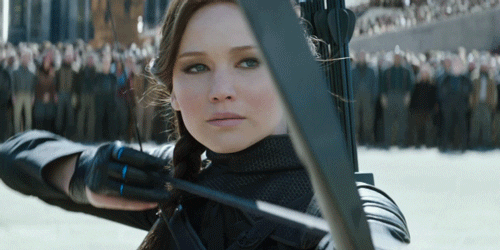
The cause of this breakup is almost always due to the transformation that the protagonist underwent during The Ordeal. The good guy no longer understands her, even though he may want to.
For example, Feyre's experience Under the Mountain sees her outgrow her coddled life with Tamlin. Similarly, when Katniss returns to 12, Gale can't fully comprehend what she went through, nor the role she is being forced to play as a result.
Grief for Lost Innocence
Refusal of the Return

The combination of The Ordeal and the Death of the Mentor take their emotional toll on the protagonist. She mourns for the girl she once was, the loss of her first love, and the ordinary world that is now a stranger to her.
What follows is a low point called The Refusal of the Return. Sometimes this beat sees the protagonist running away from her problems, as Buffy does when she flees Sunnydale after killing Angel.
Other times, The Refusal of the Return is a period of rebellion. Grief manifests itself into rage and the protagonist leans more heavily into that darker side of themselves that they discovered during The Ordeal. Like when Elena turns off her humanity following the loss of her brother.
It is usually during this stage that the bad boy begins to take on a more prominent role. (Welcome back to the plot, bad boys!)
At some point, either during this beat or perhaps earlier, we see a different side to the bad boy. Most often, this occurs when the bad boy shows the protagonist some kind of vulnerability, leading her to second guess her first impression.
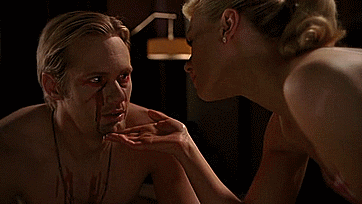
In the Darkling's case, Alina recognises his profound loneliness. Sookie witnesses Eric's grief at the loss of his maker, Godric. And Rhysand confides in Feyre about the horrors he endured at the hands of Amarantha.
However, seeing this "other" side isn't just a plot device to justify the protagonist's developing feelings for the bad boy. But rather, it serves as a mechanism through which the protagonist's assumptions and beliefs are thrown into question. Not just about the bad boy, but about the world in general.
Disrupting the protagonist's foundations is essential to nearly all emotionally-driven storytelling. Through shattering the her beliefs - whether it be in a system or person - the narrative is propelled forward as the protagonist is then forced into come to her own conclusions.
And this - THIS! - is where the "good guy / bad boy dynamic" becomes so much more than just a blatant over-simplification of male archetypes pandering to female sexual fantasy.
The dichotomy of "good" and "bad" expands here to represent larger choices that the protagonist has to make. Comfort or danger? Honour or Power? Altruism or ambition?

Furthermore, the protagonist's conflicting feelings about the two love interests underscores the very real push-and-pull we all feel during adolescence. Where we crave the adventure and independence of adulthood while simultaneously mourning the safety and protection of childhood.
And this is why the good guy / bad boy love triangle can be such a great plot device. It's not only fun to read (when done well) but it makes sense that the protagonist might find herself drawn to someone whose darkness matches her own.
Who the bad boy is - and what he has done - creates a safe space for the protagonist to explore this darker side of herself. To rebel. To fall apart. To be selfish for once, instead of selfless.

At a time when others in the protagonist's life, like the good guy or her friends, my judge or simply not understand her, the bad boy offers a reprieve. But whether this reprieve positively or negatively influences the protagonist tends to vary from story to story.
Sometimes he is the one who encourages her Refusal of the Return, as the Darkling does for Alina. Other times, the bad boy helps the protagonist in returning to her path, rather than luring her away from it, by offering her his understanding.
Peeta gets what Katniss is going through in a way Gale never can because he went through it, too. Similarly, Stefan can't provide Elena with the reassurance she needs after becoming a vampire because he has never come to terms with his own loss of humanity - therefore, enter Damon.
Self-Discovery
The Road Back Home
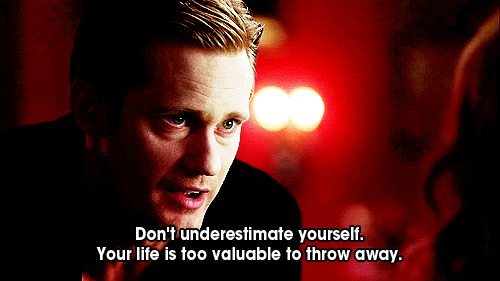
The Road Back Home sees the protagonist emerging from her Refusal of the Return. It is when she embarks on the journey to fully reconcile the girl she once was with the woman she has become. To do this, she needs to confront her trauma from The Ordeal and forgive herself for whatever darkness it might have awakened.
This is usually a gradual process that takes place over many chapters or episodes. In many ways, it is a mirror to the Crossing the Threshold beat. Except this time around, the protagonist is looking inwards not outward - instead of discovering the new world, she is discovering herself.
During this time, the bad boy's relationship with the protagonist is often explored more deeply. Being loved by the bad boy - darkness and all - is usually a precursor to the protagonist beginning to accept this darker side of herself, too.
But a distinction needs to be made here between "accept" and "embrace". The former does not necessitate the latter, and whether or not the bad boy gets his own redemption arc usually serves as the distinction between the two.

In the Darkling's case, he certainly helps Alina to come into her power, but ultimately, Alina rejects the path that he is trying to lead her down. The Darkling might have helped her to accept her darkness, but she does not fully embrace it the way he does.
Other times, when the bad boy gets his own redemption arc, we see a precursor to self-love through their relationship. Because in pursuing her feelings for the bad boy, the protagonist has to reconcile the fact that people are nuanced, and no one is entirely good nor evil. In forgiving the bad boy for his past wrongdoings, the protagonist sees that it is possible to forgive herself, too. Damon and Elena's arc (in the TV adaptation) is a good example of this.
But regardless of where things may or may not go with the bad boy, the next plot beat has nothing to do with romance at all. Now, the protagonist is ready for the final battle.
The Female Protagonist Accepts Herself
Master of Two Worlds

Everything the protagonist has been through has been leading her to this moment. Her triumphs, her defeats. Her discoveries and lessons. Her friends and mentors and lovers.
She's faced evil, maybe even embraced a little of it, and come out stronger and better for the experience. She has finished mourning the child she once was and accepted the woman she has become.
Now she is ready, as a master of both worlds, to face whatever comes next. And we, as readers, now get to enjoy the final battle!
Basically, the protagonist is a certified badass now - and she's going to win.
Now, where the romance goes during or after this plot beat is very, very varied. Sometimes, the protagonist stays with the bad boy, like Feyre does with Rhysand. Other times, the relationship is temporary, like Eric and Sookie. Or, in the case of Buffy, neither the good guy nor the bad boy remains in the picture. In fact, a very deliberate choice was made with her story to avoid an "end-game" romantic pairing.
And the reason why the romance is pretty damn varied is because, well, it doesn't really matter. The romance is the cherry on top of the story, not the whole damn cake.
Conclusion

I understand that love triangles might not be everyone's cup of tea - and that's okay. But to paint the entire trope under the broad strokes of teenage vanity and wish fulfilment is to do it a disservice.
Because for the most part, it isn't just some vapid romance. A lot of the most popular stories within the genre are actually complex YA fantasies in and of their own right, driven by your standard emotionally-driven, coming of age beats. They just happen to feature a female protagonist who falls in love.
Okay, maybe in this example she falls in love a few times. But so what? Getting your heart broken and mended again is a part of growing up, so why shouldn't it have a place in YA/NA fiction?
If young men are allowed to froth over some guy getting bitten by radioactive a spider and getting superpowers, then we can have two sexy vampires pining over the same girl.

#true blood#sookie stackhouse#southern vampire mysteries#love triangle#literature tropes#tv tropes#fantasy#fantasy romance#fantasy books#the vampire diaries#elena gilbert#buffy summers#buffy the vampire slayer#the hunger games#katniss everdeen#acotar#feyre x rhysand#feyre x tamlin#feyre#legendborn#bree matthews#shadow and bone#alina starkov#hero's journey#heroine's journey#the smut analyst#writing tips#romance plot#character building
80 notes
·
View notes
Note
love reading your rant/analysis on the mech accords vs core casters. would like to hear your thoughts on the other branches, i.e. would you say chain casters have semi-replaced splash casters?
You can't replace what was never there
See the thing is I wouldn't say Chain Casters semi-replaced Splash Casters because Splash Casters were already living under the shadow of Eyjafjalla, whose S2 just did their job but better, while being cheaper to deploy AND with a much lower SP cost on skills AND having more range.
More than Surtr and Ch'en Alter, Eyjafjalla is the one I hold responsible for having done the most damage to Arknights. Being a release 6 star Core Caster that did both Splash and Core jobs and did it better than anyone else affected an entire class for literal years.
Anyone and everyone had to get out of her way to be of any relevance. Ifrit was saved by having her then unique, straight line attack range which made her irreplaceable on certain maps, but everyone else got fucking bulldozed over.
Do you know why Patriot exists? It's Eyja's fault. The guy has 90 RES at Phase 1 because Eyjafjalla S3M3 deleted everything in sight, and when HG ran the numbers they found that only a few players actually E2'd Amiya, since she went completely ignored as soon as players pulled Eyja.
So they made this boss with the highest defensive stats they could possibly give any enemy in order to make True damage more appealing, but when that didn't work they just gated Chapter 8's finale entirely unless you E2'd Amiya then gave her a new Guard class, admitting she'd never defeat Eyja.
Every single other Caster since has been all about staying out of her way. Goldenglow boasts global range and an AFK skill to rival Eyja. Passenger got buffed twice, and THEN all the Chain Casters received really good modules that made them appealing crowd clearers. Ceobe was anti-armor and yet always did worse than Eyja at 30 RES anyway until she got her module doubling down on her anti-tank role. Ebenholz got funny oneshot capabilities to deal with enemies that even Eyja couldnt kill fast enough.
The Splash Casters already did worse AOE damage than Eyja, so when the Chain Casters took the crowd clearing role, they went all-in om their support role, which is why Mostima's module has a global slow, Dusk's 2nd module enables summon spam, and Lava the Purgatory has a +inital SP talent for Casters to enable Eyja hotdrops.
You could technically argue that Chain Casters taking the job of dealing AOE Arts damage means they replaced Splash Casters, but the issue is that it implies Splash Casters had that job at some point, and they didnt, because Eyjafjalla existed.
Honestly? If I were in HG I'd be proposing some drastic buffs to the Splash Casters, even more drastic than Mostima module x and Dusk module y. Give them 2 SP regen per second instead of 1, most of their skills are either weak, or way too expensive. Halving their downtime and making them much spammier than Core Casters would make them more appealing since theyre already trading away range, ASPD, and overall DPS vs Core Casters, and Mostima S3 plus Dusk S3 are both very powerful, but not strong enough to be utterly gamebreaking if their cooldowns are halved on top of their SP bonuses from Mostima's talent / Dusk's module.
If Mlynar S3 gets to recharge every 40 seconds while being a melee unit (which are far more flexible in placement than range), then Mostima and Dusk deserve to spam their own skills. Greyy's S2 might even be a semi-viable crowd control skill now that it doesn't take 60 whole seconds to charge to do very little.
141 notes
·
View notes
Note
Hi hello! It's me again! Sorry if I'm bothering you again, but I'm currently working on a BSD analysis-kind of post and I'd like to ask for your help again if it's not too much of a bother to you😅
I don't own the original Japanese versions of the BSD light novels, so I have no way to look this up, but I would like to ask you if you could please tell me what pronouns these characters use to refer to themselves: Rimbaud, Verlaine, Adam, the Flags, Oda, Gide, HG Wells, and Jules Verne. For example, I know that young Dazai used to refer to himself using 'boku' 僕 and that now he uses 'watashi' 私, while Chūya uses 'ore' 俺. But I'm curious to know about those other characters as well. Oh, and could you please tell me if they write their pronouns in hiragana, katakana, or kanji?
I apologize again for coming to bother you like this and I thank you in advance for your help!🙇🏻♀️ I hope you have a wonderful day/night!!
Here is the list of pronouns that these characters use. Pronouns are written in kanji, with the little hiragana on the right when the pronunciation is uncommon (e.g, Akutagawa’s pronoun is “yatsugare”, but the kanji used is the same as the kanji for “boku”)
- Rimbaud: 私 (watashi)
- Verlaine: 俺 (ore)
- Adam: 当機 (touki) - directly translated to “this machine” but he used 私 once to disguise himself when talking to police officer at where Shirase was kept.
- Pianoman: 私 (watashi)
- Albatros: 僕 (boku)
- Doc: 私 (watashi)
- Lippman: 私 (watashi)
- Iceman: 俺 (ore)
- Oda: 私 (watashi)
- Gide: 乃公 (actually pronounced as “daikou” but is read as “ore” in the novel - a pronoun that males use to address themselves proudly, and also when speaking to people in lower positions than themselves)
- HG Wells: 私 (watashi)
- Jules Verne: 私 (watashi)
Hope it helps.
114 notes
·
View notes
Photo
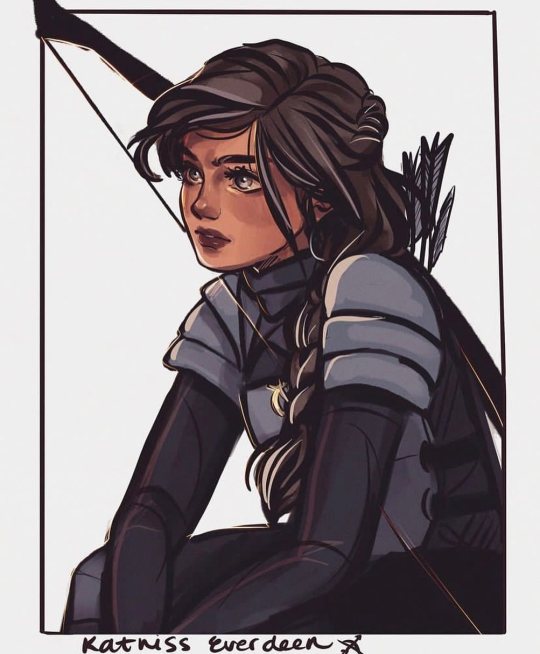
We've come to the end of our Hunger Games read-through (😭), and unsurprisingly we discuss Katniss quite a lot in the final episode. We have been so happy to hear that some of you found a new love for Katniss during our analysis of the books, because she is *such* a fantastic character.
This fanart by @smoustart is an amazing depiction of #KatnissEverdeen and highlights how young she was during the Games and war. Oh Katniss. 🖤
👉 Listen to our read-through on your podcast app, via our biolink, or at: https://bit.ly/mockingjay-podcast
And don't forget about our post-HG resources: https://bit.ly/post-hg-resources
#katnisseverdeen#Katniss#katniss everdeen#THE GIRL ON FIRE#girl on fire#the mockingjay#THG#thg fanart#THG trilogy#THG Katniss#Hunger Games#The Hunger Games#Panem#may the odds be ever in your favor#Hunger Games Podcast#The Hunger Games Podcast#hunger games post#strong female characters#poc characters#hunger games renaissance
46 notes
·
View notes
Note
i am not on tiktok... what are some of the worst hg meta/takes you've seen there? like is it bad bad or
HAHA honestly i don’t go on tik tok much anymore but i do keep getting youtube recommendations for “analysis” of katniss and i’m just like… i can’t even watch this bc i know they won’t get it right lol. so far the worst is my irl friend telling me to see tbosas because snow is hot (😭😭😭) and my other friend saying “i didn’t care about the book but the movie was good!!” and i was just like 🙂 that’s great 🙂
7 notes
·
View notes
Text
For you fans of Dracula Daily who need more public domain literature in your life without the 6-month slowburn, @nsomniacsdream and @somethingusefulfromflorida would like to welcome you to Hellsite's Only Book Club
Starting in March, each month we'll be reading a different novel (available for free online as PDFs), and posting about them as we make our way through. Every day we'll meet new and interesting characters and learn all about their peculiar 19th-to-early-20th century habits before they go on life changing adventures!
First on the docket will be HG Wells' 1895 classic The Time Machine. We'll break the story down into 31 chunks and post a summary of events each day. We invite you to follow along and join in the discussion. Whether you're looking for an in depth analysis or you just want to riff on it like your own personal Mystery Science Library 3000, Hellsite's Only Book Club is where you can post your 2 cents.
We'll post the outline this week so you know how far to read each day. It'll be just like 12th grade English class, but without the judgement and standardization of the American education system. There'a no barrier to entry, the point is simply to have fun and read old books like they're brand new.
#books#book club#Literature#the time machine#hg wells#1895#dracula daily#public domain#follow along#read along#bookblr#book blog#booklr#monthly#hellsitesonlybookclub#hobc
39 notes
·
View notes
Note
So now that the velma mega cut is up(love it btw ‼️) do you have any plans for what you'll talk about or do next? Not necessarily even in terms of analysis, I suppose I'm just asking what's next for your channel
I have a good few ideas for videos coming up! I am a little intimidated by how much research some of them might need but there are a lot of topics I really want to talk about.
Next up I want to talk about something positive! There were a few ideas I had but someone in my livestream reminded me that the best topic to cover would be one I feel personally passionate about, rather than something topical or "current". Since both Velma and HGS were both super popular topics on youtube, I worry about keeping viewer attention with other topics, but I also don't want to be a trend chaser either. So I am trying to figure all of this out. Sadly there's no guide on how to do youtube correctly when it comes to subject matter. Which makes it a little scary for me because I like following blueprints on how to do things to ensure a better chance of success.
One thing I think will be next is a video to help people figure out if they'd actually want to watch Utena or not. because I know several people who are really intimidated by it knowing a few details, or who are worried about how triggering it may be, or people who are just not sure if they'd be interested. So I think just making a single video kind of as an introduction would be fun and I can try my best to stop myself from researching things that don't need to be researched and make more work for myself which I don't need to.
There are several other topics, but I want to be more careful saying what I plan on doing because the ADHD means I may change my mind completely when my interest shifts and I have no control over that. So I don't want people to feel like I promised a video on a certain topic and then I don't cover it. And since my sub count is climbing to a relatively higher number by now, I want to be more careful not to disappoint people.
But Utena has been my favourite anime since 2010 so I think that's a save topic to discuss XD

12 notes
·
View notes